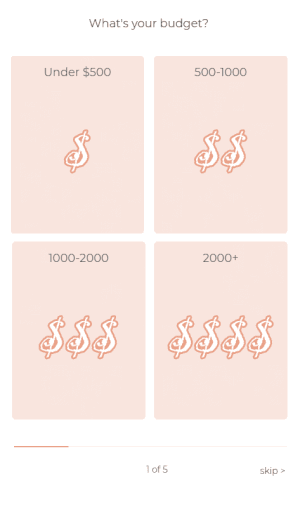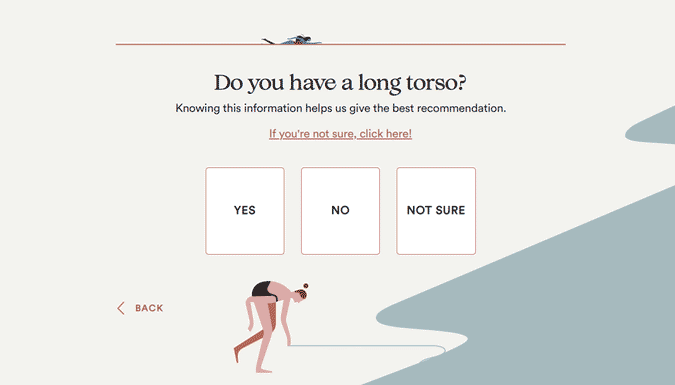For eCommerce merchants, product recommendation quizzes are a great way to engage new visitors, encourage product discovery, grow your subscriber list, and drive sales.
We’ve covered the benefits of eCommerce product quizzes in a previous post. Now, we’ll cover the steps to build a quiz that engages and converts more customers.
What is a product recommendation quiz?
A product recommendation quiz is a short quiz that asks about you or the person you’re shopping for, then uses your answers to return the ideal product(s). Just as an in-store associate would guide shoppers to the right product, quizzes allow you to offer a concierge experience online.
Take a look at this quiz example. In Health-ade’s flavor quiz, shoppers answer questions about their taste preferences and health habits, then the quiz connects them with the perfect kombucha.
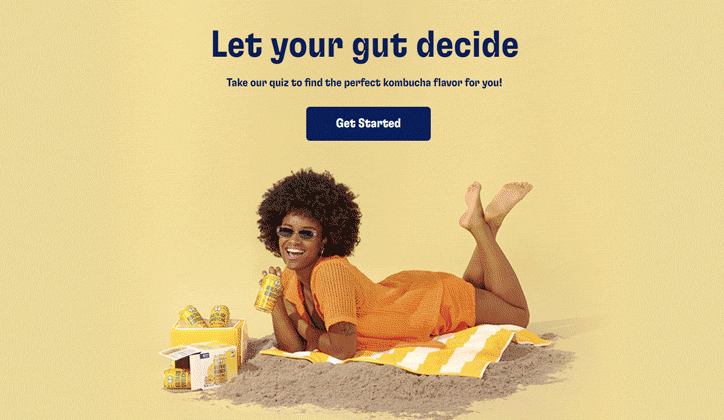
While the quiz invites users to sign up for emails, providing the email is optional. Users can click the button to see their results without providing their email. After all, if the quiz leads to a sale, you can collect the email later!
The power of product quizzes isn’t limited to consumer goods. Here’s an example of a product quiz template for a travel site.
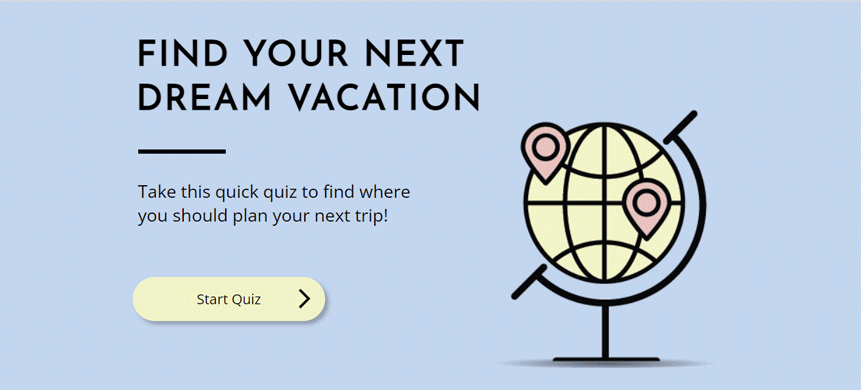
Unlike the kombucha quiz, this quiz recommends a single experience that best fits a traveler’s goals.
Want to see additional quizzes? Get inspired with these product recommendation quiz examples.
Product Quizzes vs. Product Recommendation Engines
eCommerce quizzes typically recommend products based on predetermined logic, making them different from AI-powered product finders or recommendation engines.
While recommendation technology uses complex algorithms to suggest products for shoppers based on browsing behavior, quizzes collect preference data directly from shoppers to make recommendations. This allows you to suggest products, collect data, and drive sales without having to train an AI solution. In fact, you can typically implement product quizzes quickly using an online form or quiz builder.
Many quiz apps integrate with Shopify, Magento, WooCommerce, and other eCommerce platforms to show tailored product recommendations to every site visitor.
Build the Perfect Product Recommendation Quiz
Whether you develop your quiz in-house, build it with Digioh, or use another solution, they come down to the same basic steps: writing, design, data capture, integration, launching, and promotion.
1) How to Write an Effective Product Quiz
Because quizzes rely on predefined logic to make recommendations, it’s important to think through your quiz before writing it. Consider:
- What is the purpose of your quiz? Identify what customers can expect from your quiz, whether that’s their ideal skincare product, gift, health supplement, etc.
- What products will you feature? If you have an endless catalog of SKUs, you may pare it down to a single category of products, or create a separate quiz for each category. If you want to highlight new products or move older inventory, you can strategically promote them in your quiz.
- How many questions will you ask? Ask too few, and your recommendations may miss the mark; ask too many, and you reduce the chances of completion.
- What questions will you ask? If you’re stuck, review questions and feedback from current customers. What do shoppers struggle with when picking a product? What misconceptions do your shoppers have? Use this data to inform your quiz.
- What data should your quiz capture? Quizzes are great for capturing zero-party data for segmentation. Balance informing your audience with informing your marketing efforts.
- How will you align your quiz with your brand’s voice? Quizzes tend to be fun and engaging. This is an opportunity to let your brand voice shine through. If you have a lively brand, you can even throw in some quirky personality questions.
- How will you capture your audience’s attention? For visitors to complete your quiz, you have to convince them to take it first. Write a strong CTA and make sure your CTA is clearly visible across your site.
Then, decide whether your quiz will show a single recommendation, recommend multiple products, or show a product bundle. Shown below, Moon Juice’s quiz allows you to bundle product recommendations and save. Shoppers can also subscribe to products at a reduced price.
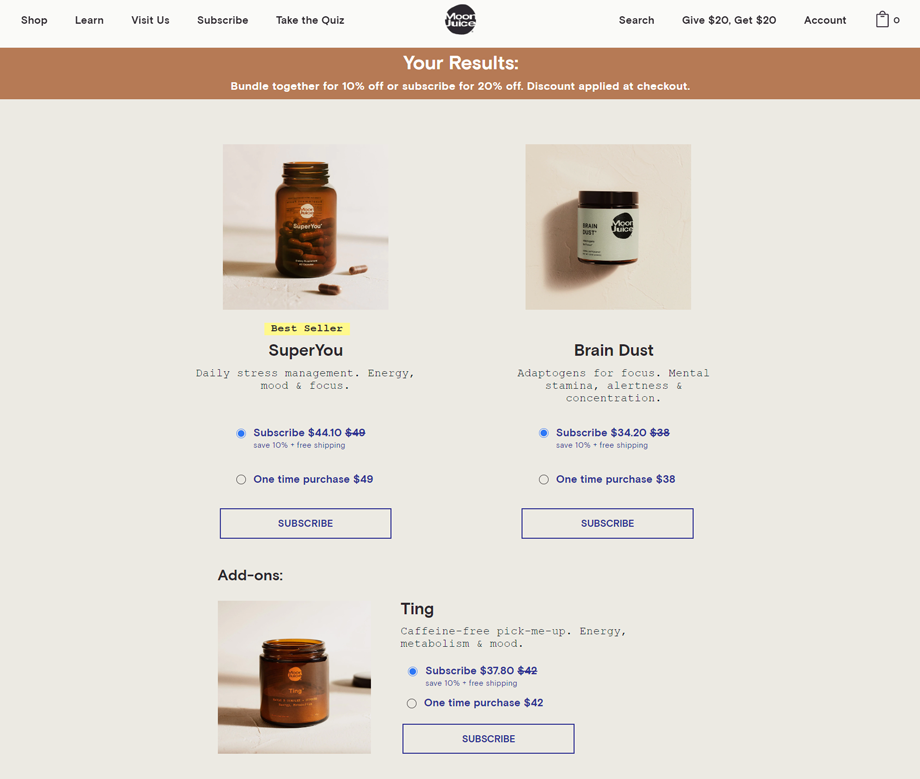
Quizzes should help shoppers make a decision, so don’t overwhelm them with too many recommendations. Still, you may want to provide quiz takers with options, so make sure your quiz solution supports showing multiple recommendations.
As you finish writing your quiz, think through how questions and answers will map to the products your quiz recommends:
- Some answers may map to a single product, while other answers may fit multiple products.
- Use branching logic to show different questions based on answers to previous questions. This helps you ask only necessary questions, making it more likely that visitors complete your quiz.
- If your quiz builder supports weighted questions, you can apply more weight to more important questions. For instance, if you ask for the shopper’s price range, weigh this question more heavily to fit the recommendation in their budget. Or, if a visitor says that something is a deal breaker, you can weight that answer to ensure such products don’t appear in their results.
With the branching logic, weighting, and mapping in place, you can design your quiz.
2) Designing Your Quiz
Digioh’s quiz builder allows users to build custom product quizzes with ease. But these tips apply whether you use a dedicated quiz solution or develop your quiz in-house.
First, think about the form factor of your quiz. Like multi-step forms, you have the option of designing a quiz that shows up in a pop-up, or you can embed your quiz on page.
Regardless, you need a strong visual CTA to draw visitors into your quiz. Quiz funnels can quickly convert new site users into subscribers, so make sure new visitors know about your quiz! Show a pop-up or teaser that combines your CTA copy with eye-catching images and a button. This CTA should match your branding, but stand out so visitors see it.
AgaveLux promotes their quiz with an exit-intent pop-up. This gives them a chance to convert shoppers who may leave because they don’t see any spirits they like.
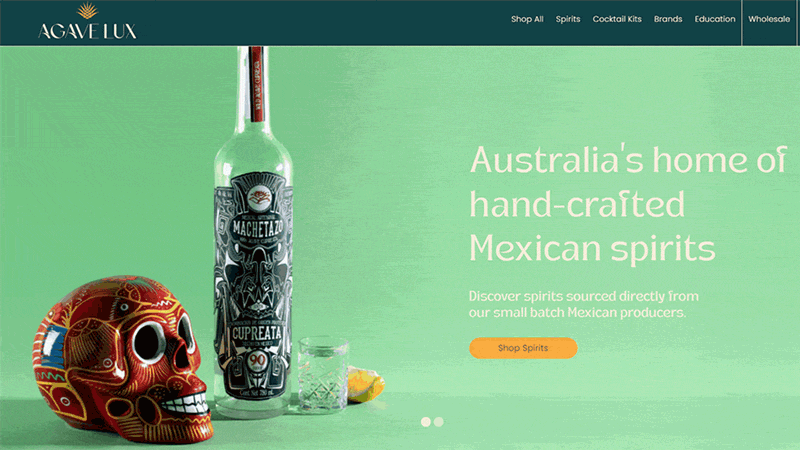
With Digioh, you can even target these CTAs to visitors, allowing you to put your quiz in front of the right people. For instance, if a visitor comes from Facebook, you may want to capture their email address ASAP with a quiz. Once visitors complete the quiz, you can prevent them from seeing it again.

Whether embedded or in a pop-up, make sure your quiz works well on mobile devices. Follow mobile design best practices:
- Use responsively-designed quiz CTAs and pages. You can also create separate versions of your quiz for mobile and desktop users, then target visitors with their corresponding version.
- Make sure buttons and selectors are large enough to be comfortably pressed on a mobile screen.
- Avoid selectors that don’t work well on mobile. As cool as sliders are, they work better on desktop than mobile. Keep this in mind if you have a large mobile audience.
- Provide enough spacing between elements so users don’t accidentally press the wrong choice.
- If you promote your quiz with a mobile pop-up, make sure it follows Google’s guidelines on mobile interstitials and does not harm the mobile user experience.
- Test your quizzes across multiple devices.
If your quiz builder provides built-in templates, you can start there, or build a design from scratch.
As you design each page, use visual elements to keep visitors engaged. Show pictures that go along with your answer choices, such as product images.
The answer choices in your quiz may be only images, without accompanying text. This example dress quiz balances text and images perfectly, providing illustrated examples of each choice:
The quiz above also includes a progress bar at the bottom. This bar shows shoppers how long they have until they finish the quiz. Seeing their progress may lead users to seek a sense of completion by finishing the quiz.
But just because they’re called progress bars doesn’t mean they have to be bar-shaped! The bar on Andie’s swimwear quiz “swims” across the screen, adding a great touch to an already great-looking quiz.
While your main quiz goal is probably to increase sales, quizzes are also good at collecting email addresses. If you plan to capture emails or mobile numbers with your quiz, the next step is critical.
3) Using Product Quizzes to Grow Your Email List
Quizzes allow brands to capture email addresses and other data from users who complete the quizzes. To collect the email address from your quizzes, you can:
- Allow users to save their results to email.
- Require users to enter their email to see their quiz results.
- Ask users to optionally provide their email.
- Offer a discount for that product in exchange for their email.
The quiz below follows the second approach, requiring users to enter their email before seeing their final recommendation.
This approach ensures you get an email address for each visitor who completes the quiz, but it can also cause higher quiz dropoff rates.
Alternatively, you can make it optional for shoppers to provide their email address. In the example below, the quiz asks visitors for their email address (or mobile number), but shoppers can click a link to view their quiz results immediately.
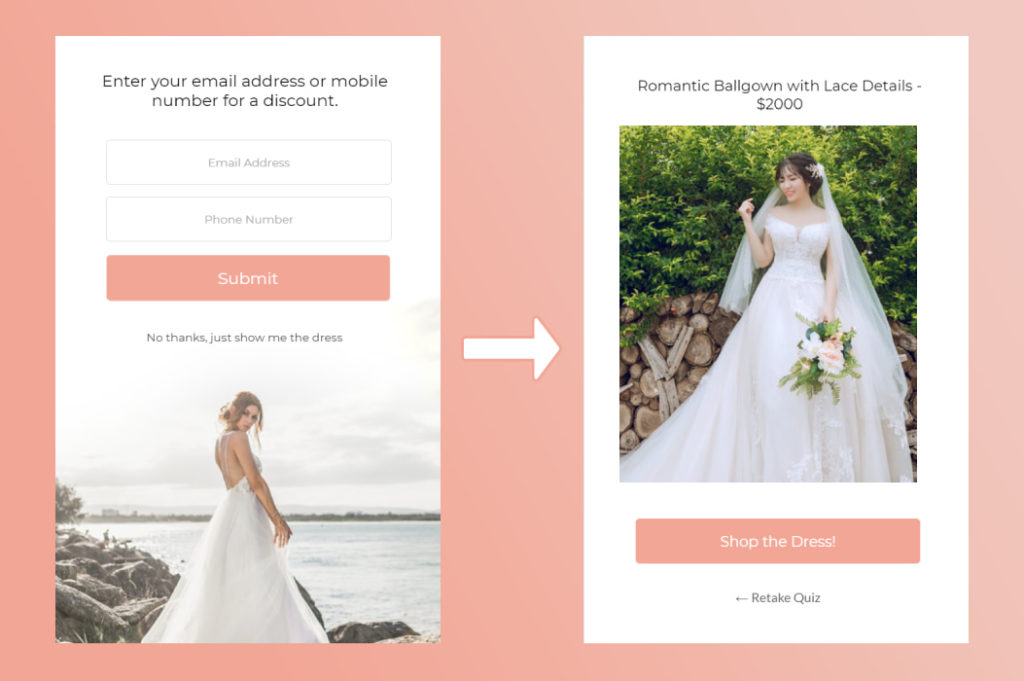
Tip: If you make the email address optional and still see high dropoff rates, try making your “skip” link bigger or easier to see.
Unsure which approach to take? Try A/B testing versions of your quiz where the email address is optional vs. mandatory. Keep an eye on how each version impacts both quiz completions and revenue. While capturing an email is nice, you may find that letting visitors see their results without it leads to more sales.
Each approach can collect emails and other data effectively, but how do you put this data to use?
4) Integrating Your Quiz with Your eCommerce/Email Platforms
Before going live, it’s important to connect your quizzes with your tech. This will help you get the most from your quiz investment.
For instance, if your quiz integrates with your eCommerce platform, you can include a one-click “add to cart” button on your quiz results screen. Pressed’s Shopify quiz allows shoppers to add items to their cart individually or as a bundle.
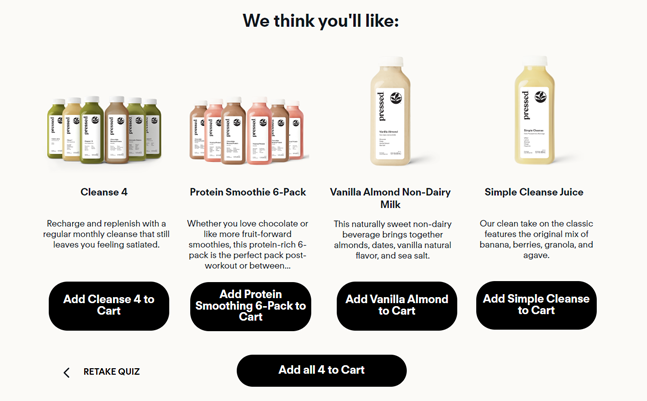
When making a purchase is that easy, shoppers may be more likely to convert.
By integrating your quiz with your email service provider (ESP) or marketing automation platform, you can trigger emails that engage visitors beyond the quiz by:
- Sending their product recommendation results to their email.
- Segmenting your list by preferences indicated in the quiz.
- Reminding visitors to purchase their recommended product with follow-up emails.
- Delivering additional recommendations based on items they browse.
- Preventing browse and cart abandonment with triggered, personalized emails.
- Incentivizing shoppers to purchase items with a one-time-use, unique coupon code.
For instance, the personalized email below shows the user’s recommended products, as well as a unique coupon code.
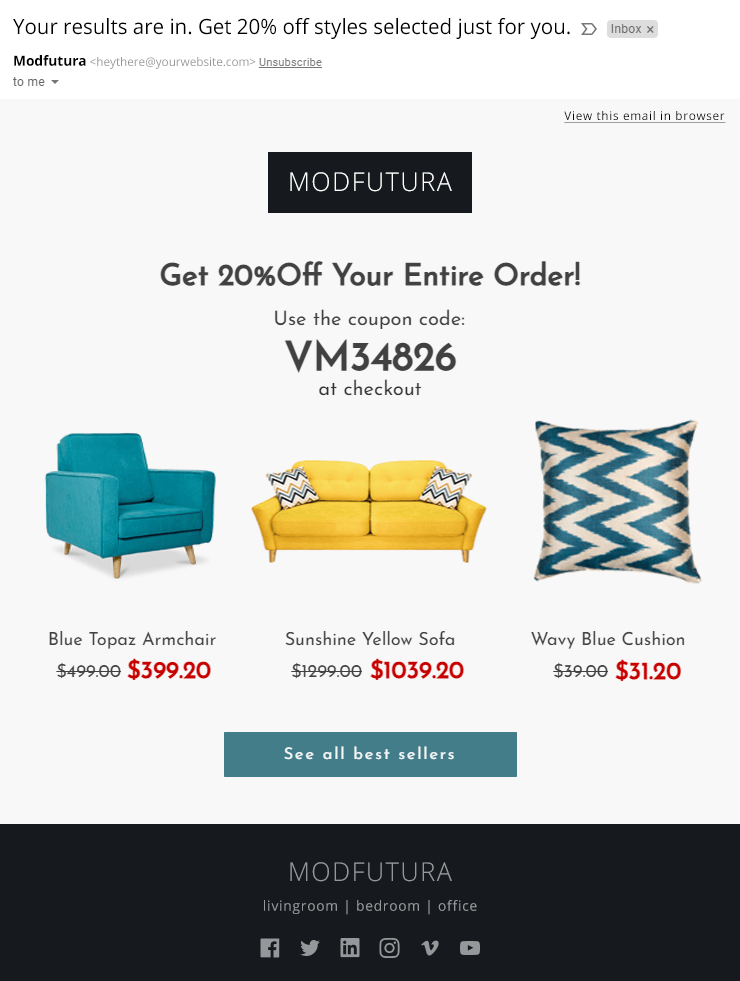
Many quiz builders have built-in integrations with the most popular martech providers. Digioh’s quiz builder integrates with hundreds of technology providers, including Salesforce Marketing Cloud, Segment, Iterable, Klaviyo, Omnisend, and many more. If you use an in-house solution or need a more complex integration, Digioh can also create custom integrations.
5) Launching Your eCommerce Quiz
Once your integration is set up, you’re ready to launch your quiz. If you use a quiz builder solution, it likely has a place where you can access the required code. Paste this code into your store’s site using the instructions they provide.
If you use Digioh to create your quiz, just install our JavaScript snippet on your site. Then, your quizzes and other pop-ups will appear based on your targeting options. There’s no need to edit this code or install additional code if you want to launch additional forms or quizzes. Once the code is on your site, you can edit forms and CTAs in Digioh without having to edit your store’s code.
6) Promoting Your Product Quiz with Email, Social Media, and Paid Advertising
If you promote your quiz with a pop-up teaser or other CTA on your site, your site visitors are sure to see your quiz. But how do you draw everyone else to your quiz?
That’s where other marketing channels will come in handy.
Once your quiz is live, spread the news by promoting it on social media or paid channels. In a quiz funnel marketing strategy, quizzes provide a great way to drive new visitors to your site, grow your email list, and convert social followers into direct email subscribers.

By promoting your quiz to your existing email list, you can 1) nudge subscribers who haven’t converted into customers yet, or 2) create repeat customers by pointing them toward new products.
Of course, if you send your quiz to your subscribers, there’s no need to collect their email again. Provide a better user experience for these subscribers by pre-populating their email in your quiz, or target them with a different version of your quiz that skips the email question.
Digioh can help you set up this targeting, allowing you to win new customers while keeping current customers happy.
Ready to start making your product recommendation quiz?
These steps should provide the foundation you need to build a product recommendation quiz. For more ways to optimize your quiz for conversion, check out “How to Make a Product Recommendation Quiz that Converts.”
If you still need more information or want to try Digioh’s quiz solution, reach out to us!
Originally posted in April 2021, this post was updated in June 2023 to add new examples and tips.



